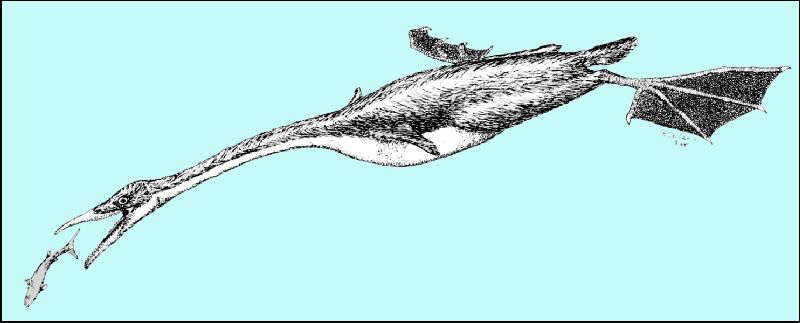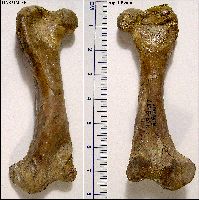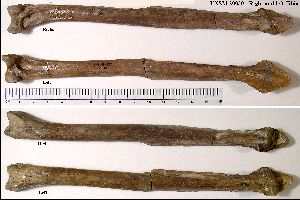Cracraft, J. Phylogenetic relationships
and monophyly of Loons, Grebes, and Hesperornithiform birds, with comments on the early
history of birds. Systematic Zoology 31(1): 35-56.
Cumbaa, S. L., C., Schröder-Adams, R. G.
Day, and A. Phillips. 2006. Cenomanian bonebed faunas from the Northeastern margin,
Western Interior Seaway, Canada; pp. 139-155 in S. G. Lucas, and R. M. Sullivan (eds.), Late Cretaceous
vertebrates from the Western Interior. New Mexico Museum of Natural History and Science
Bulletin 35.
Elzanowski,
A. and Brett-Surman, M. K. 1995. Avian premaxilla and
tarsometatarsus from uppermost Cretaceous of Montana. Auk 112(3): 762-767.
Everhart, M.J. 2005. Oceans of Kansas - A Natural History of the Western
Interior Sea. Indiana University Press, 322 pp.
Everhart, M.J. 2011. Rediscovery
of the Hesperornis regalis Marsh 1871 holotype locality indicates an
earlier stratigraphic occurrence. Kansas Academy of Science, Transactions 114(1-2):59-68.
Everhart, M.J. and Bell, A. 2009. A hesperornithiform limb bone from the basal
Greenhorn Formation (Late Cretaceous; Middle Cenomanian) of north central Kansas. Journal
of Vertebrate Paleontology 28(3):952-956.
Fürbringer, M. 1888.
Untersuchungen zur Morphologie und Systematik der Vögel, zugleich ein Beitrag zur
Anatomie der Stütz – und Bewegungsorgane; Verlag von Tl.J. Van Holkema, Amsterdam, 1751 p.
Galton, P. M. and
Martin, L. D. (2002): Enaliornis, an Early Cretaceous Hesperornithiform bird from
England, with comments on other Hesperornithiformes. 317-338. In: Chiappe, L. M.
and Witmer, L. M. (eds.): Mesozoic Birds: Above the Heads of Dinosaurs. University
of California Press, Berkeley, Los Angeles, London
Gingerich, P. D. 1973. Skull of Hesperornis and early
evolution of birds. Nature 243: 70-73.
Gingerich, P. D. 1975. Evolutionary significance of
the Mesozoic toothed birds. Smithsonian Contributions to Paleobiology 27: 23-34.
Gregory, J. T. 1951. Convergent evolution: The jaws of Hesperornisand the mosasaurs. Evolution, 5:345-354.
Gregory, J. T. 1952. The jaws of the
Cretaceous toothed birds Ichthyornis and Hesperornis. Condor
54(2):73-88, 9 figs., 1 table.
Lane, H. H. 1946. A survey of the fossil vertebrates of Kansas,
Part IV, The Birds, Kansas Academy of Science, Transactions 49(4):390-400.
Marsh, O. C. 1872. Discovery of a remarkable fossil bird. American Journal of
Science, Series 3, 3(13): 56-57.
Marsh, O. C. 1873. Fossil birds from the Cretaceous of North
America. American Journal of Science, Series 3, 5(27):229-231.
Marsh, O. C. 1875. On the Odontornithes, or birds with teeth.
American Journal of Science, Series 3, 10(59):403-408, pl. 9-10.
Marsh, O. C. 1876. Notice of new Odontornithes. The American
Journal of Science and Arts 11: 509-511.
Marsh, O. C. 1877. Characters of the Odontornithes, with notice of
a new allied genus. American Journal of Science 14:85-87, 1 figure. (Naming and
description of Baptornis advenus)
Marsh, O. C. 1880. Odontornithes:
A monograph on the extinct toothed birds of North America. U.S. Geol. Expl. 40th
Parallel (King), vol. 7, xv + 201 p., 34 pl. (Synopsis of American Cretaceous birds,
appendix 191-199)
Marsh, O. C. 1883. Birds with Teeth. 3rd Annual Report of the
Secretary of the Interior, 3: 43-88. Government Printing Office, Washington, D.C.
Marsh,
O. C. 1893. A new Cretaceous bird allied to Hesperornis.
American Journal of Science 45:81-82.
Martin, J. E. 1982. The occurrence of Hesperornis in the
late Cretaceous Niobrara Formation of South Dakota. Proceedings of the South Dakota
Academy of Science 71(95-97).
Martin, J. E. and Cordes-Person, A.
2007. A new species of the diving bird Baptornis (Ornithurae:
Hesperornithiformes) from the lower Pierre Shale Group (Upper Cretaceous) of southwestern
South Dakota. The Geological Society of America, Special Paper 427: 227-237.
Martin,
J. E. and Varner, D. W. 1992. The highest stratigraphic occurrence of the fossil bird Baptornis. Proceedings of the South Dakota Academy
of Science 71:167 (abstract).
Martin, L. D. 1980. Foot-propelled diving birds of the Mesozoic;
pp. 1237-1242 in Acta XVII Congress of International Ornithology.
Martin, L. D. 1983. The origin
and early radiation of birds. Chapter
9 (pp 291-338) in Bush, A. H. and
Clark, G. A., Jr. (eds.), Perspectives in
Ornithology. Cambridge University Press, Cambridge.
Martin, L. D. 1984. A new hesperornithid and the
relationships of the Mesozoic birds. Kansas Academy of Science, Transactions 87 p.
141-150.
Martin, L. D. and O. Bonner. 1977. An immature specimen of Baptornis
advenus from the Cretaceous of Kansas. The Auk 94:787-789.
Martin, L. D. and J. D. Stewart. 1996. Implantation and replacement of
bird teeth. Smithsonian Contributions to Paleobiology 89:295-300.
Martin, L. D. and J. Tate, Jr. 1966. A bird with teeth. Museum
Notes, University of Nebraska State Museum, 29:1-2.
Martin, L. D. and J. Tate, Jr. 1976. The
skeleton of Baptornis advenus (Aves: Hesperornithiformes). Smithsonian
Contributions to Paleobiology 27: 35-66.
Mudge, B. F. 1877. Annual Report of the Committee on
Geology, for the year ending November 1, 1876. Kansas Academy of Science,
Transactions, Ninth Annual Meeting, pp. 4-5. (discovery of Uintacrinus socialisin Kansas, Pteranodon, sharks and birds.)
Rees, J., and J.
Lindgren. 2005. Aquatic birds from the upper Cretaceous (Lower Campanian) of Sweden and
the biology and distribution of Hesperornithiforms. Palaeontology 48:1321-1329.
Seeley, H. G. 1876. On the British fossil Cretaceous birds. Quarterly Journal of the
Geologic Society of London 32: 496-512.
Shufeldt, R. W. 1915. The fossil remains of a
species of Hesperornis found in Montana. Auk 32(3): 290-284.
Shufeldt, R.W.
1915. Fossil Birds in the Marsh Collection of Yale University. Transactions of the Connecticut Academy of Arts and
Sciences 19: 1-110, 15 pl.
Snow, F. H. 1887. On the Discovery of a Fossil Bird Track
in the Dakota Sandstone. Kansas Academy of Science, Transactions 10:3-6
Sternberg, C. H. 1917. Hunting Dinosaurs in the Badlands of the
Red Deer River, Alberta, Canada. Published by the author, San Diego, Calif., 261 pp.
Tokaryk, T. T., S. L. Cumbaa, and J. E. Storer. 1997.
Early Late Cretaceous birds from Saskatchewan, Canada: the oldest diverse avifauna known
from North America. Journal of Vertebrate Paleontology, 17:172-176.
Townsend, C. W. 1909. The use of the wings and
feet by diving birds. Auk 26(3): 234-248.
Walker, M. V. 1967. Revival of interest in the toothed birds of Kansas.
Kansas Academy of Science, Transactions 70(1):60-66.
Williston, S. W. 1898. Birds. The
University Geological Survey of Kansas, Part 2, 4:43-53, pls.5-8.
Williston, S. W. 1898. Bird tracks from the Dakota Cretaceous. The
University Geological Survey of Kansas, Part II, 4:50-53, Fig. 2. (Re-publication of
photograph originally published by Snow, 1887)

















